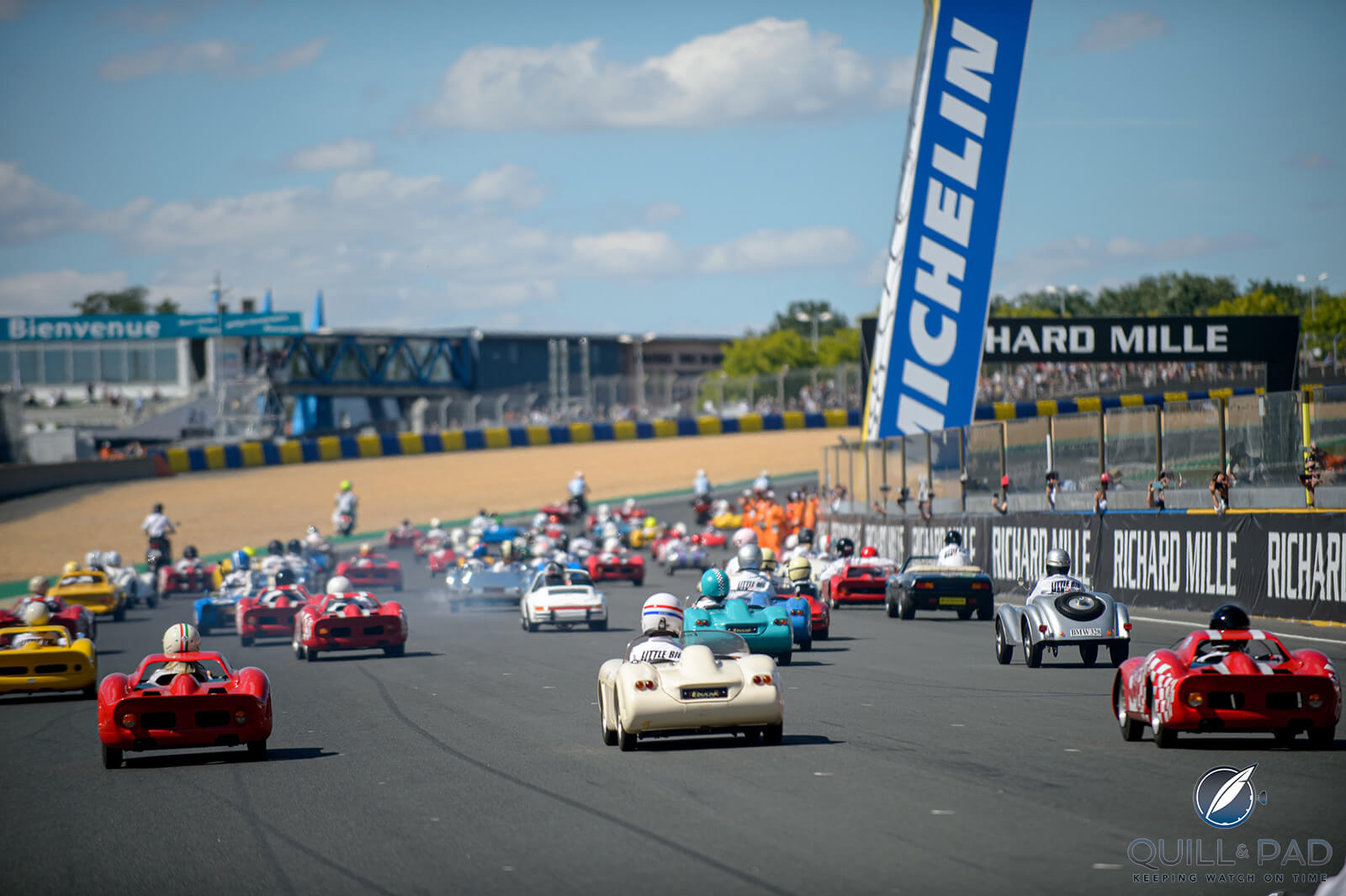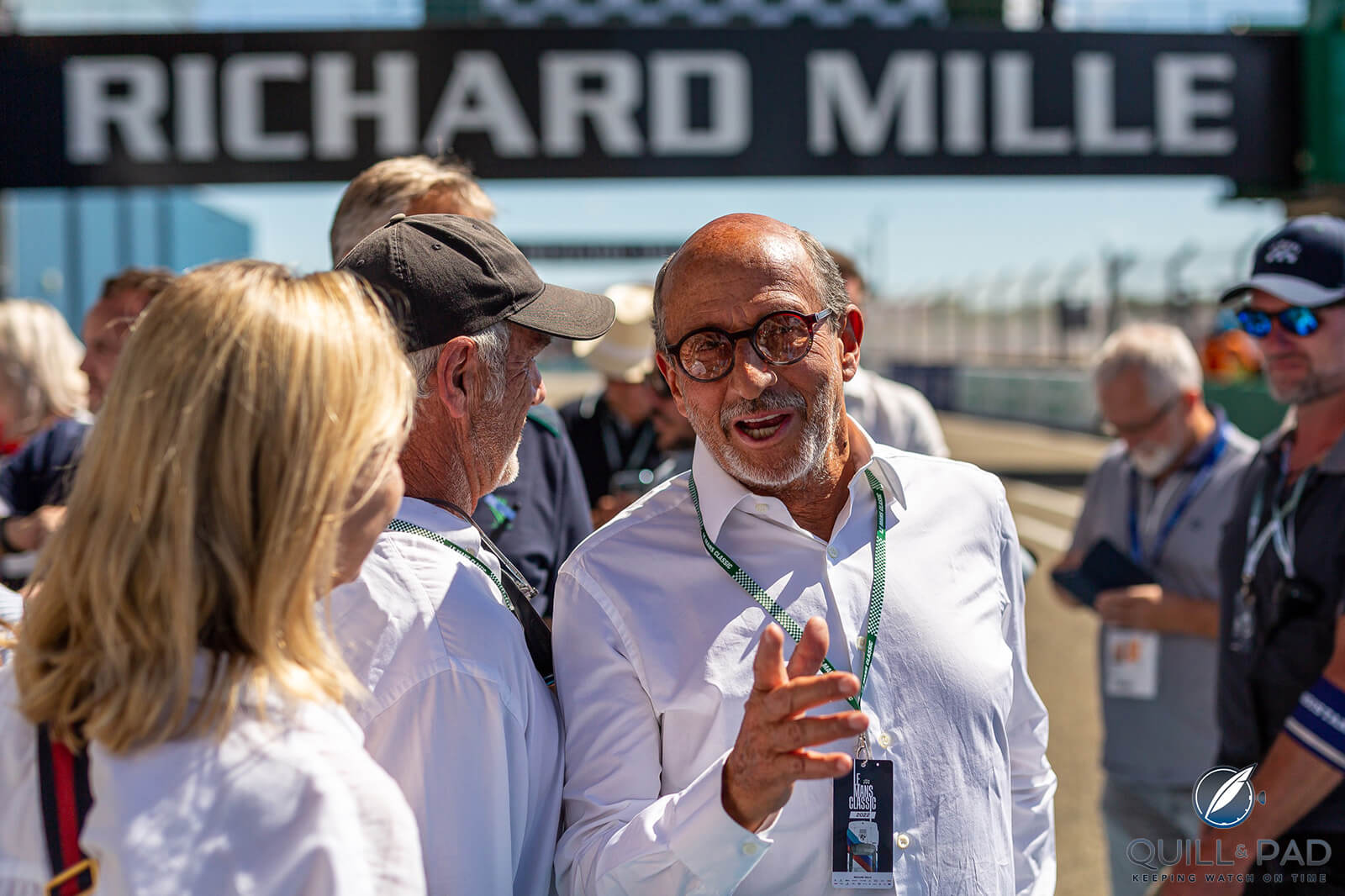Rows and rows of cars everywhere you turn. A 1925 Bugatti T35, a 1931 Alfa Romeo 8C 2300 LM, and a 1964 Ferrari 250 GTO here; a 1965 Ford GT40, a 1975 De Tomaso Pantera Gr. IV, and a 1981 Porsche 924 Carrera GTR there.

Le Mans Classic 2022 (photo courtesy Kristof Vermeulen)
Le Mans Classic offers motorsport enthusiasts one of the rare occasions anywhere on the planet to admire these legendary cars going head to head on the fabled Circuit de la Sarthe in Le Mans, France. For four days in early July, the biannual classic automobile race with its heady mix of aesthetics and performance hosted a record 200,850 spectators and over 1,000 gentlemen and professional drivers from more than 25 countries, including the UK, France, Italy, Japan, and the United States – featuring seven former 24 Hours of Le Mans champions such as Emmanuele Pirro, Marco Werner, and Kazuki Nakajima – driving some 700 race cars on the track.

Le Mans Classic 2022 (photo courtesy Kristof Vermeulen)
It is the world’s largest gathering of its kind: 8,500 vintage cars grouped by brand and model from automobile clubs around Europe were also on display. Richard Mille returned as main sponsor and official timekeeper of the event for the tenth time running. Passionate about the automobiles that marked his youth, Mille, who entered one of his own cars in the race – a 1969 Lola T70 Mk 3B – which was driven by his son Armand, says, “I’ve always been crazy about technical subjects and mechanics. My passion for automobiles dates back to my childhood and has only grown over the years. To this fervor was subsequently added an utter fascination with beautiful classic cars.”

Little Big Mans race for 100 children competing in scale-model replicas of cars that had raced in Le Mans at Le Mans Classic 2022 (photo courtesy Christophe Jouniaux)
Under the blazing sun, I was held under the spell of the heady smell of burning rubber and motor oil, the screeching of tires, the roar of engines tearing down long straight stretches into hairpin bends, the incredible excitement, the speed, danger, crashes, clashes, losses, victories, and glory on the racetrack as day turned into night and day again.
Four hundred fifty automobiles made between 1923 and 1981 – all having either won or competed in the 24 Hours of Le Mans in their day – competed in turns according to period, arranged into six grids with 18 races from Saturday to Sunday. It’s not the first vehicle past the checkered flag that wins, but the best of three 45-minute races (one in complete darkness) multiplied by a handicap factor, with some cars switching drivers during the pit stop.

Le Mans Classic 2022 (photo courtesy Kristof Vermeulen)
For decades, the race began from a unique standing start with the cars, engines off and parked at an angle, and the drivers standing on the starting line before running to their cars, which is ceremonially imitated today.
Richard Mille and Le Mans Classic
Richard Mille has sponsored Le Mans Classic from its start in 2002 as well as other historic car events including Chantilly Arts & Elegance, Rétromobile, Nürburgring Classic, and Rallye des Princesses.

Richard Mille enjoying himself at the Le Mans Classic 2022 (photo courtesy Kristof Vermeulen)
“It’s about sharing the same passion and the same values and seeing cars that you don’t see being driven on public roads and not stuck in a garage or just being exhibited in museums,” explains Richard Mille marketing director Timothée Malachard. “For us, watches are designed to be worn and cars are designed to be driven, so that’s what these events are about. The classic cars at Le Mans Classic are of all values – some are worth €50,000, some are worth tens of millions of euros – but the people who have these cars who are going racing have the same passion. So it’s not just how much money they’re worth, it’s that they share common ground, and that’s what we like.”
Richard Mille RM 029 Automatic Le Mans Classic
For each edition of Le Mans Classic since 2008, Richard Mille has released a dedicated limited-edition timepiece inspired by automotive history: from the RM 011 skeleton flyback chronograph and the RM 010 with 24-hour display to the RM 008 chronograph tourbillon, the RM 11-02 with annual calendar, flyback chronograph, 24-hour counter, UTC display, and countdown, and the RM 11-03 with 24-hour flyback chronograph.

Richard Mille RM 029 Automatic Le Mans Classic
“Richard Mille himself, when he founded the brand, was passionate about motor racing and especially the technology in race cars, and that passion for motor racing and technology has inspired our watches since day one,” notes Malachard. “So that is the real center line of what we do, and everything we do today uses the same materials and alloys that you get in the aviation and Formula 1 industries, such as TitaCarb, which is titanium and carbon. We’re a brand that likes to push the limits, and that’s what motor racing is about.”

Richard Mille RM 029 Automatic Le Mans Classic
Available in only 150 pieces, this year’s RM 029 Automatic Le Mans Classic, powered by skeletonized grade 5 titanium Caliber RMAS7 driven by twin spring barrels, comes in Le Mans Classic’s signature colors. A case band milled from a solid block of white Quartz TPT features a bezel in green Quartz TPT inlaid with trademark double Le Mans stripes in white Quartz TPT running from 12 to 6 o’clock – a first for the brand. A 24-hour counter at 2 o’clock pays tribute to the 24 hours of the race, with a blue arrow pointing to the 4:00 pm start time, while a sporty, vented white rubber strap ensures long-term comfort.
Le Mans Classic highlights
Le Mans Classic highlights included the Porsche Classic Race with more than 70 historic Porsches. The German carmaker holds the record with 19 outright victories in the 24 Hours of Le Mans, Little Big Mans for 100 children aged from 7 to 12 competing in scale-model replicas of those that had raced in Le Mans, and the first edition of the Endurance Racing Legends support race featuring GTs and prototypes from the 1990s and 2000s (Aston Martin DBR9, Bentley Speed 8, Cadillac Northstar LMP-01, Dodge Viper GTS/R, Ferrari 333 SP, etc.) to attract younger audiences. Representing the golden age of endurance racing and bringing together the track’s stars from the ’80s to early ’90s, the Group C Racing event celebrated its fortieth anniversary.
“I think the highlight is seeing the passion there is for automotive engineering and cars since 100 years,” discloses Malachard. “Whether you are a big car fan or not, you can walk around the paddocks and get close up to the race cars that you only usually see in books or in posters, which today in motor racing you can’t do. In Formula 1, to go into the box, you need to be a partner to a Formula 1 team and pay a lot of money to get inside, whereas here you pay your €60 or €80 to be a spectator and you can get really close. That’s the attraction for the public to come to such an event and see such a variety of cars from the 1920s to the latest cars from the last 10 or 15 years.”

Le Mans Classic 2022 (photo courtesy Kristof Vermeulen)
As McLaren Automotive was invited, I was even treated to a hot lap around the full 13.6-km, half racetrack, half public roads circuit (which is only open twice a year) in a McLaren 720S by British professional endurance race car driver Oliver Webb, who tackled the Dunlop Chicane, hurtled full speed down the Hunaudières long straight, and attacked the tight Mulsanne and Indianapolis corners with ease.
He went on to take home first prize in a 1961 Jaguar E-Type 3.8 in the Jaguar Classic Challenge and came in fourth overall in a 1965 Porsche 911 2.0L in Grid 4 of the main race. What a way to end the weekend!

Little Big Mans at Le Mans Classic 2022 (photo courtesy Kristof Vermeulen)
And there’s good news for vintage race car lovers: you don’t have to wait until 2024 for the next edition. As an exception to the regular timing, Le Mans Classic will be back next summer to celebrate the centenary of the 24 Hours of Le Mans.
For more information, please visit www.richardmille.com/collections/rm-029-automatic-le-mans-classic.
Quick Facts Richard Mille RM 029 Automatic Le Mans Classic
Case: 40.10 x 48.15 x 13.10 mm, green and white Quartz TPT
Movement: automatic Caliber RMAS7 with free-sprung balance with variable inertia, twin spring barrels, base plate and bridges in hand-ground, wet-sandblasted grade 5 titanium, 55-hour power reserve, variable-geometry rotor
Functions: hours, minutes, seconds; large date, 24-hour display
Limitation: 150 pieces
Price: $176,000
You may also enjoy:
Richard Mille (All-Female) Racing Team And The (Virtual) 24 Hours Of Le Mans




















































